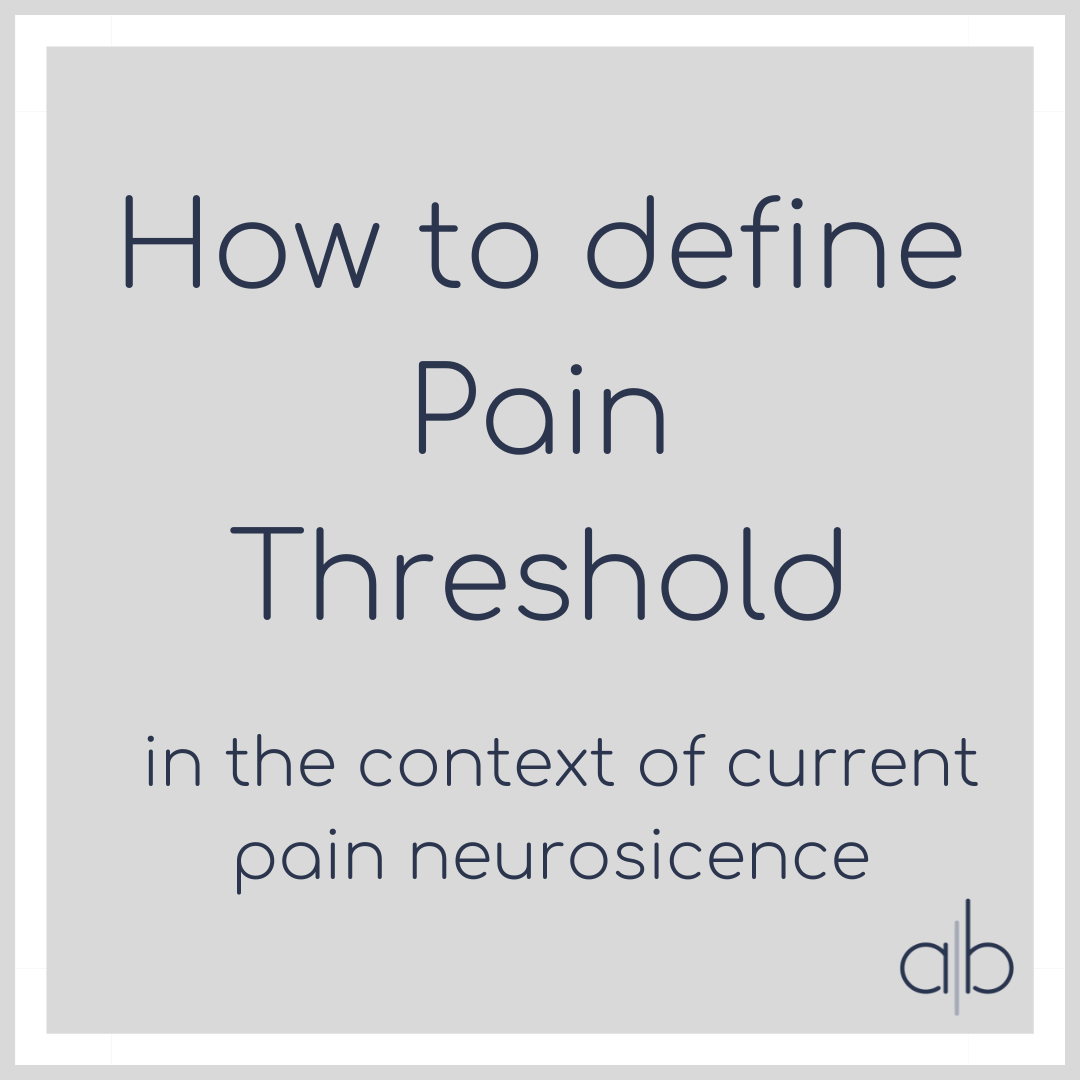How do we define Pain Threshold
in the context of pain neuroscience?
I’m sure you’ve heard people say, “I have a high pain threshold” when describing their ability to deal with pain or even feel pain. Maybe you’ve also heard pain threshold used interchangeably with pain tolerance. The two terms refer to different concepts about pain in our bodies, which I’ll clarify below. To define pain threshold and pain tolerance in the context of our current understanding of pain illuminates some of the basic tenets of pain neuroscience.
Pain tolerance vs. pain threshold
There are two associations that can be made when someone refers to their pain threshold. Either:
1. The person is referring to the fact that they can tolerate high amounts of pain while reacting very little to it, if at all.
2. The person is referring to the amount of stimulus required to produce a painful effect.
In actuality, the first is a reference to pain tolerance and the second is a reference to pain threshold. For example, you and your friend are each getting pin-pricked in your right index finger in the exact same way. You both rate the pain at 2 out of 10 on the pain scale (where 0 is no pain and 10 is excruciating). Your friend winces at the onset of the prick while you don’t flinch. This means that even though both of you report experiencing the same level of pain according to your own subjective rating, you have a higher tolerance to that pain in that moment than your friend. You didn’t react. This is pain tolerance.
Now imagine the same scenario, but you rate the pain at a 2 while your friend rates the pain at a 6. You each received the same stimulus, but it produced a less painful output for you than for your friend. In this case, you have a higher threshold to reach a certain pain response than your friend because you need more stimulus than your friend to reach your subjective pain level of 6. Maybe four finger pricks in a row would get you there. This is pain threshold.
The first example, pain tolerance, is a reflection of one’s conscious experience of pain and behavior around pain. The second example, pain threshold, is your system’s subconscious tolerance to stimulus before it reaches the threshold it needs in that moment to produce a pain output.
Ok. Let’s backtrack a little bit to give the above more context.
Pain is always a felt experience.
A new client, Max, was sharing his relationship with pain and describing his knee pain with deep squats. He said something to the effect of, “I think I have a high pain tolerance – I often have knee pain yet I don’t feel it.” This statement introduces a fundamental piece of pain physiology upon which everything else stands:
Pain is always a felt experience. No exceptions. Inherent to the definition of pain is our ability to feel it consciously. If you can’t feel pain, you’re not in pain. This is because pain is a conscious output of the brain rather than a separate entity residing in the tissues of our bodies as is often thought.
So, Max couldn’t have had pain and not felt it. What Max was trying to say is that he has a high pain threshold. Based on what we learned above with the two pin-prick scenarios, Max’s system needs a lot of stimulus to prompt his brain to alert him with a conscious pain response. There are situations with his knee where he assumes, possibly based on other people’s experiences or things he’s been told, that he should feel pain, yet he doesn’t.
Pain is always subjective, but the pain scale tool is not.
Going back to the pin prick scenario — two people can have the same stimulus, the pin prick, and feel very differently about it. This illustrates that pain is subjective in nature. The 0-10 pain scale often used in rehab settings is a tool for someone to communicate the intensity of their experience to a professional. The scale is objective in nature. The scale’s terms are set: 0 is no pain and 10 is excruciating/intolerable with many options in between to rate intensity. A 10 to me is the same as a 10 to you. We are both in excruciating, intolerable pain; however, how we each got to that point could be wildly different. You’ve probably heard stories of soldiers at war getting limbs blown off and not feeling any pain. On a pain scale, they would choose 0. I’m also currently at a 0 while writing this post. We’re both experiencing the same pain intensity level of 0 with very different contexts.
Pain is the result when your body surpasses its threshold for tolerating threat.
Our bodies are constantly exposed to threats. These threats come from biological, psychological, and social contexts. Examples could be anything from viral particles, hormonal changes, bumps in the sidewalk, thinking about people we don’t like, environmental noise, unhealthy foods, past experiences, extreme August heat – anything that causes our body to fluctuate away from homeostasis. Most of the time, our bodies self-manage these threats under the radar. They do this by way of three main physiological systems: our musculoskeletal, immune, and hormonal systems are ever fluctuating in response to these threatening changes to keep us in balance. When the summation of threats to our body becomes too much for these regulating systems to handle on their own in any given moment – aka when our bodies have reached a certain threat-management threshold, our bodies enlist help. Through complex communication processes, these systems signal to our brain, “Hey, there’s too much going on here and we really need the commander in chief (our conscious selves) to do something!” Enter pain. Pain grabs our attention and usually forces us to change our behavior.
Everyone’s body has a different threat-management threshold.
What determines how much threat your musculoskeletal, immune, and hormonal systems can handle on their own before enlisting your conscious, active help? Basically everything. This threshold is different from person to person and from moment to moment for each person.
So, how do we define pain threshold and tolerance?
Someone’s pain threshold is the moment at which one’s body has reached its capacity to self-manage the numerous threats to its survival and alerts the conscious being with a pain signal to incite behavior change. This threshold is unique to the individual, dependent upon bio-psycho-social factors, and is constantly fluctuating.
Someone’s pain tolerance is a measure of how intense their experience of pain needs to be to incite behavior change. In other words, it’s a measure of one’s willingness to be in pain. This tolerance is unique to the individual, dependent upon psychological and social factors, and can fluctuate.
What does this mean for you?
Your pain threshold can change!! And so can your pain tolerance. We have the ability to use some of the listed items in the photo to enhance our body’s capacity to self-manage threats so that we get alerted only when it’s really necessary. And when we do have pain, understanding how pain works has been shown to make the pain experience itself less scary / more tolerable, which in turn has been shown to impact the trajectory of that pain experience.
While genetics always play a role, we are not born with a set pain threshold or set pain tolerance. We are active agents in our pain experiences. Next time you refer to your pain threshold or tolerance, do you know which one you mean? What are you trying to communicate about your pain? Do any of the items on the list in the photo have an impact on what you’re feeling?
Till next time, keep moving.
Related Reading:
Does Thinking About Pain Make it Worse?
The Stress Tolerance Bucket Analogy for Pain
Context Matters with Pain


